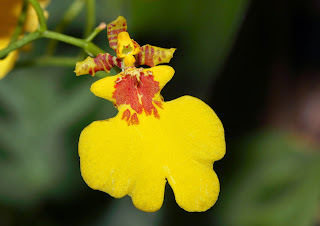MOTH ORCHID is an appropriate common name for the genus
Phalaenopsis,
bringing to mind night in a distant, tropical jungle, the darkness broken
only by a cloud of white flowers fluttering in the warm breeze. Phalaenopsis spesies
have distribution from Himalayas of northern India, Tibet and China, down
through Southeast Asia and into the island countries of Malaysia, Indonesia and
the Philippines. Northern Australia and New Guinea.
 |
| Phalaepnosis Amabilis |
GENERAL CHARACTERISTIC
All phalaenopsis, whatever their flowering habit, have a
number of characteristics in common. While the flower size, color and thickness
of segments can vary tremendously, the flower structure of phalaenopsis does
not. Unlike Paphiopedilum flowers, where the smaller, lateral sepals
fuse to form the ventral sepal which counterbalances the larger, dorsal sepal,
the three sepals of a typical Phalaenopsis flower arc nearly identical
in size and evenly spread apart, forming a triangle of sorts. The lateral sepals
may vary in coloration from the dorsal sepal, as is the case with Phalaenopsis
stuartiana. Here the lateral sepals arc spotted heavily in brown while the
dorsal sepal is only lightly speckled in pink at the base. The two petals of
any Phalaenopsis flower, on either side of the dorsal sepal, can be
larger or about the same size as the sepals, often "filling in" the
space between the lateral sepals and dorsal sepal.
Though largely unappreciated, the Phalaenopsis lip
or labellum is the most complex segment of the flower. Positioned
between the two lateral sepals, the Phalaenopsis lip has three sections,
or lobes. The two side-lobes are usually raised at an angle to the central or
front lobe. The front-lobe, typically to some degree spade-shaped, juts forward
or somewhat downward. Phalaenopsis stuartiana has a front-lobe with two
tail-like appendages called cirrhi, a characteristic for its section of
the genus though not for all Phalaenopsis species. At the junction of
the three lobes of a Phalaenopsis lip is a raised area called the
lip-callus. It appears just below the nose-like protuberance which is the
column, the fusion of male and female parts, in the center of a Phalaenopsis
flower.
Phalaenopsis have a distinctive appearance. They are
monopodial orchids with vegetation produced indefinitely from a single, apical
growing point. This is in contrast to paphiopedilums, which arc sympodial and
produce new growths from the base of the previously flowered growth. In theory
phalaenopsis would continue to grow taller, year after year. Just the same,
only rarely does one sec a phalaenopsis in cultivation much over 30 cm (1 foot)
tall. The lowermost leaves tend to die after several years, and the plants are
then often "topped", with the upper, leaved portion repotted in new
mix. Like paphs, phalaenopsis form "fans" or "rosettes",
with closely clustered leaves which emerge from the terminal growing point . These
leaves are longer than they are wide, in cultivation usually between 20 and 30
cm (8-12 inches) long on mature plants, though the leaves of Phalaenopsis
gigantea, for example, live up to their name, being up to 45 cm (1.5 feet)
long in the wild. Like paphiopedilums, some phalaenopsis, such as Phalaenopsis
stuartiana and Phalaenopsis schilleriana have attractive,
mottled leaves, while Phalaenopsis amabilis displays solid green leaves.
Even without mottling, Phalaenopsis leaves on a healthy plant present a
glossy, pleasing appearance. Phalaenopsis roots, unlike those of
paphiopedilums, often seek the open air and ramble out-of-pot. Their growing
tips are greenish or reddish-brown, though away from the tip they are often
whitish, even slivery in appearance when healthy. The inflorescences of
phalaenopsis emerge successively along the stem between the axils of the
leaves.
ORCHID'S BASIC CARE
An American Orchid Society demographic survey showed that
phalaenopsis have become America’s favorite orchid. And no wonder. Perhaps no
other orchid is better suited to home orchid growing. Plants with long-lasting
sprays of lovely mothlike blooms in a broad array of colors are inexpensive and
widely available, ready to give weeks of pleasure in your home or office.
Simply provide modest light and
consistent moisture, and they will delight you with their relative ease
of culture. The main flowering season is late winter into spring, though
commercial growers today can make flowering phalaenopsis available year round.
LIGHT
Sufficient light is important for healthy growth and flower
production. Provide bright light, no direct sun. In the home, an east, west or
shaded south window. In a greenhouse, about 30 percent full sun. Under lights,
four 40 watt fluorescent tubes and two 40 watt incandescent bulbs directly over
plants. Foliage should be naturally semierect, and of a medium olive-green.
Dark green, limp foliage indicates too little light.
TEMPERATURE
Mature plants need a 15 to 20 F difference between night
and day. Provide nights of 60 to
65 F; days of 75 to 85 F. Seedlings need temperatures five to 10 degrees higher
than mature plants.
WATER
Mature plants should seldom dry out between waterings.
Seedlings need more constant attention to moisture.
HUMIDITY
Phalaenopsis need 60 to 70 percent humidity. In the home,
place on trays of moistened pebbles. In greenhouse, use a humidifier if
conditions are too dry.
FERTILIZER
Must be provided on a regular basis because most potting
media have little. Provide the exact fertilizer you use will depend on the mix
in which your plant is growing. A good general rule is to use a balanced
(10-10-10, 12-12-12 or similar ratio) fertilizer “weakly, weekly.” That is,
fertilize every week at one quarter to one half of the recommended dilution.
POTTING
Should
be done every one to two years before the mix breaks down too far. Best done in
late spring after main flowering season, using a well-drained but water-retentive
mix. Select pot size for root mass, not top size.




























